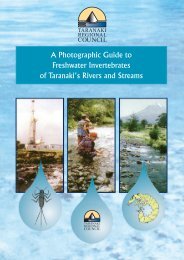safety data sheet
safety data sheet
safety data sheet
You also want an ePaper? Increase the reach of your titles
YUMPU automatically turns print PDFs into web optimized ePapers that Google loves.
- indicates not tested<br />
� Shading indicates 15% effectiveness criterion used to indicate likely field effectiveness<br />
Test method generally underestimates dispersant effectiveness on light crude oils and overestimates<br />
dispersant effectiveness on fuel oils<br />
Full test results avavilable in Cawthron Technical Reports<br />
Effectiveness test results of Maritime NZ dispersant stocks on NZ Crude Oils<br />
Crude oil<br />
source<br />
Water<br />
Temp<br />
Corex<br />
it<br />
9500<br />
Corex<br />
it<br />
9527<br />
Gam<br />
len<br />
OSD<br />
LT<br />
Slickg<br />
one<br />
LTSW<br />
Slickg<br />
one<br />
NS<br />
Tui Crude 15º X � X � X X<br />
10º X<br />
Tergo<br />
2005<br />
Comment<br />
Maari Crude 18.5º � X X X X X - The oil can be dispersed only<br />
at the earlier stage of its<br />
weathering,<br />
- Weathered oil, with its high<br />
pour point, is not favorable to<br />
chemical dispersion.<br />
Manaia<br />
Crude<br />
18º<br />
10º<br />
Kupe Condensate - Kupe Condensate has a relatively high pour point and high wax content. If<br />
the seawater temp is above the oil pour point, natural dispersion and<br />
evaporations rates are likely to be high. Chemical dispersion is generally<br />
undesirable because it will reduce evaporative losses and transfer the most<br />
toxic oil fractions into the water.<br />
- When sea temperature is below the pour point, or following weathering,<br />
spilt oil is likely to solidify relatively quickly or form a low toxicity waxy residue<br />
after the light ends evaporate. In either state, the effectiveness of chemical<br />
dispersants will be greatly limited as it will be difficult to apply them at the oilwater<br />
interface where they work.<br />
Maui Condensate Dispersant use not considered necessary due to rapid evaporation of vast<br />
majority of oil.<br />
Dispersant Application<br />
Sea state<br />
Calm conditions<br />
In very calm conditions there may be insufficient energy in the sea to create the small droplets<br />
required for effective dispersion of the oil. Consequently, care must be taken to ensure that either<br />
suitable agitation is provided to break up the treated oil or dispersant is not applied in these conditions.<br />
Rough conditions<br />
When the wind reaches Force 5 (17 – 21 knots) and above, the natural turbulence of the sea means<br />
that oil will be regularly covered by breaking waves. Under these conditions the application of<br />
dispersants can lead to excessive wastage as the water prevents dispersant reaching the oil. In<br />
National Marine Oil Spill Contingency Plan Page 5 of 45<br />
Chapter 7 – Dispersants Use Issue 7 June 2012














